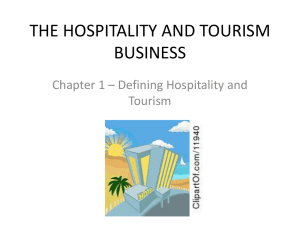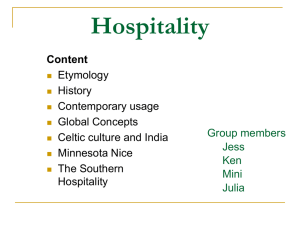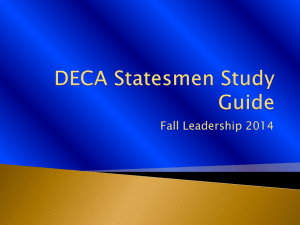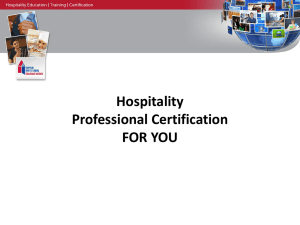The World of Hospitality Chapter 1 HS
advertisement
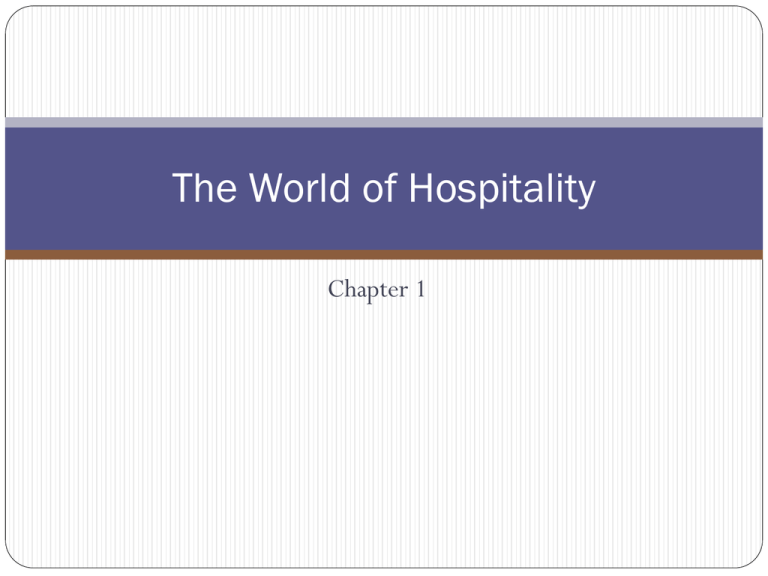
The World of Hospitality Chapter 1 Introduction Hospitality: mean meeting the needs of guests with kindness and goodwill. Hospitality Industry: provides services to people away from home Food, lodging (place to sleep), recreation, and travel Hospitality industry is sometimes called the travel & tourism industry Travel industry or tourism industry Service is at the heart of the hospitality indsutry Size & Economic Impact Travel & Tourism is the world’s largest industry Expected to group by 4% each year through 2019 Has a major impact on national economies around the world More than 18 million people in the US work in the hospitality industry It is the second largest employer (health care is 1st) Size & Economic Impact Hospitality generates more than $1 trillion each year in the US Whenever people travel, they spend money International visitors to the US place over $100 BILLION into our economy Federal, state, and local government collect taxes on many hospitality purchases Major impact on countries Diversity Diverse: made of elements that are different from each other Many businesses in the hospitality industry are different from other businesses Think about when you used the hospitality industry People who work in the industry are also different Complexity Term used to describe the hospitality industry Complex: made of 2 or more parts Some of the parts are complex in that they cannot be separated from one another Food & Beverage Food & Beverage Industry: businesses that prepare food for customers – also known as the foodservice industry Known as F & B Range from casual to fancy, fine dining Food and beverage provide nearly 76% of all meals eaten in the US today American food & beverage is the largest and most varied part of the hospitality industry (employs over 11 million people) The number of people in the foodservice industry is expected to double in by 2015 Lodging Lodging: place to sleep for one or more nights Accommodation: another word often used to mean a place to sleep Lodging Industry: consists of businesses that prove overnight accommodations. Lodging Property: business that provides overnight accommodations Lodging businesses vary from expensive resort hotels to budget motels Accommodations can be found to fit any price range and level of service There are more than 4 MILLION guest rooms in approximately 60,000 different facilities throughout the US There are about 13 MILLION rooms worldwide What are some examples of lodging properties? Recreation Recreation: any activity that people do for rest, relaxation, and enjoyment The goal of recreation is to refresh a person’s body and mind Different people enjoy different types of recreation Recreation industry: consists of businesses that provide activities for rest, relaxation, and enjoyment Four types of recreation: Entertainment, attractions, spectators sports, and participatory sports Recreation Industry Entertainment business: provides a show for you to watch (movies, live theater, concerts) Attractions: places of special interest to visit (natural scenery, museums, zoos, historical sites) Spectator Sports: sports that you watch others play (football game) Participatory Sports: sports that you take part in yourself (skiing, snowboarding, etc.) Travel & Tourism Travel industry: consist of businesses that physically move people from one place to another. (Also known as the transportation industry) Taxi services, car rentals, bus services, train services, airlines Tourism industry: consists of businesses that that organize and promote travel and vacations Travel agencies, tour operators, cruise companies, meeting & convention planners, convention & visitors bureaus, and local and national tourism bureaus One of the main functions is to plan vacations & tours Vacation may involve several different hospitality businesses Package: Trip that includes several segments of the hospitality industry such as transportation, lodging, meals, and entertainment Travel & Tourism (continued) Tourism industry promotes and encourages travel Role of Travel Travel is the basis for much of the hospitality industry Two main types of travel: Business & Pleasure Pleasure travel: travel that is done rest & relaxation Paid for by discretionary income (money that you have left over after all your expenses/bills are paid) Vacation: period of time during which a person rests and is free from daily obligations (school, work) 346 MILLION trips a year are taken for pleasure Average 3.7 nights per trip Business Travel Business travel: travel that people do as part of their jobs Employer decides where you and when you go 210 MILLION trips a year are taken Working Together All of the segments of the hospitality industry work together to successfully meet customer needs On a typical trip, guests use businesses from all four segments If a worker in any segment makes a bad impression, the guest may go away with a bad impression of the whole city, state, country Business Structures You need to know about business structures in hospitality Two basic structures Single Unit Multiple Units Single Unit Single unit business: business that only has one location and one unit (Also called an independent business) Not part of any other business Owner is responsible for all the business decisions Make decisions about décor, recipes, staff, how much to charge, etc. Multiple Unit Multiple Unit Business: business that consists of more than one unit or more than one location 2 Structures Chain Franchise Chain Chain: business that has more than one location under the same name and ownership Example: Olive Garden (owned by Darden Restaurants, Inc.) Darden decides on décor, menu items, prices, and even what servers will wear Most important aspect of a chain is the brand Brand: name, logo, tagline, or any combination of these that distinguishes a product from its competitors (association) Franchise Franchise: the right to do business using the brand and products of another business Franchise is actually part of a chain Chain owner can give the outside person the right to use the chain’s name and sell the chain’s products Franchise Agreement: legal document that sets up a franchise. It includes the rules and standards that the outside person must follow in running the franchise Franchise Fee: Amount of money the outside person pays the chain owner Franchisor: The person who owns the chain Franchisee: The person who busy the rights to use the brand Professional Associations Professional Association: group of people who have organized themselves to work to improve themselves, their profession, and their industry (aka professional organizations) AH&LA (American Hotel & Lodging Association) NRA (National Restaurant Association) Work in 5 areas: Professional development Standards & ethics Networking Public relations Government relations Professional Development Professional development: process of continuing your education in your profession after you leave school (continuing professional education) Present educational workshops, seminars, and lectures on the latest developments Take place at conventions, trade shows Standards & Ethics Organizations also develop standards for the practice of their profession Certificate Programs Code of Ethics: statement of proper, professional behavior for members of the profession Networking Networking: process of meeting people in your profession Social gatherings Provides opportunity to meet others to problem solve, learn new ideas, and to learn about career opportunities FUN Public Relations Public Relations: providing information about the industry to the general public Two purposes: Inform the public about the profession to attract new professionals Build a positive image of the profession and industry Government Relations Government relations: informing local, state, or national governments about the issues that are important to the profession Staff members who speak with legislators about issues affecting the industry and profession Value of Involvement Many advantages Scholarships to students More up to date on current issues/training Stay informed and do a better job Employers appreciate Give you the opportunity to grow Career and Technical Student Organizations Career and Technical Student Organization (CTSO): organization for students with an interest in a career area, such as hospitality or business. The purpose is to give students the opportunity to develop interpersonal leadership, career, and technical skills Usually a chapter in the schools

